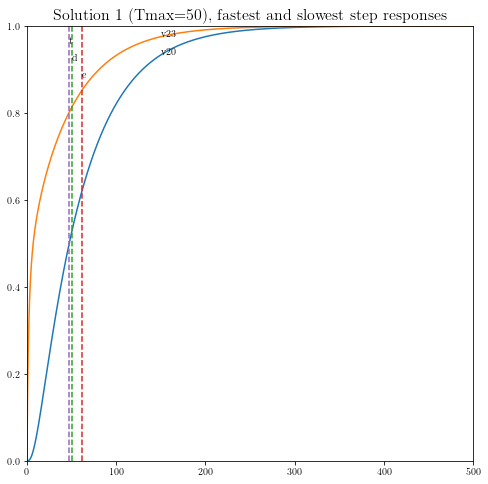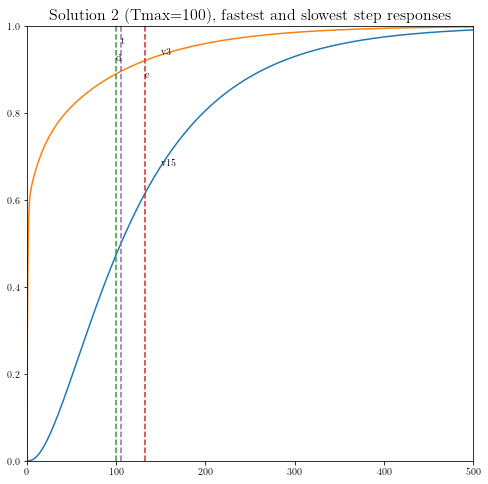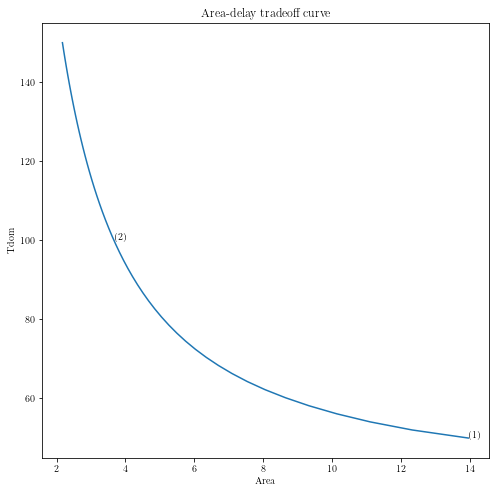Sizing of clock meshes¶
Original by Lieven Vanderberghe. Adapted to CVX by Argyris Zymnis, 12/4/2005. Modified by Michael Grant, 3/8/2006. Adapted to CVXPY, with cosmetic modifications, by Judson Wilson, 5/26/2014.
Topic References:
Section 4, L. Vandenberghe, S. Boyd, and A. El Gamal “Optimal Wire and Transistor Sizing for Circuits with Non-Tree Topology”
Introduction¶
We consider the problem of sizing a clock mesh, so as to minimize the total dissipated power under a constraint on the dominant time constant. The numbers of nodes in the mesh is \(N\) per row or column (thus \(n=(N+1)^2\) in total). We divide the wire into m segments of width \(x_i\), \(i = 1,\dots,m\) which is constrained as \(0 \le x_i \le W_{\mbox{max}}\). We use a pi-model of each wire segment, with capacitance \(\beta_i x_i\) and conductance \(\alpha_i x_i\). Defining \(C(x) = C_0+x_1 C_1 + x_2 C_ 2 + \cdots + x_m C_m\) we have that the dissipated power is equal to \(\mathbf{1}^T C(x) \mathbf{1}\). Thus to minimize the dissipated power subject to a constraint in the widths and a constraint in the dominant time constant, we solve the SDP
Import and setup packages¶
import cvxpy as cp
import numpy as np
import scipy as scipy
import matplotlib.pyplot as plt
# Show plots inline in ipython.
%matplotlib inline
# Plot properties.
plt.rc('text', usetex=True)
plt.rc('font', family='serif')
font = {'weight' : 'normal',
'size' : 16}
plt.rc('font', **font)
Helper functions¶
# Computes the step response of a linear system.
def simple_step(A, B, DT, N):
n = A.shape[0]
Ad = scipy.linalg.expm((A * DT))
Bd = (Ad - np.eye(n)).dot(B)
Bd = np.linalg.solve(A, Bd)
X = np.zeros((n, N))
for k in range(1, N):
X[:, k] = Ad.dot(X[:, k-1]) + Bd;
return X
Generate problem data¶
#
# Circuit parameters.
#
dim=4 # Grid is dimxdim (assume dim is even).
n=(dim+1)**2 # Number of nodes.
m=2*dim*(dim+1) # Number of wires.
# 0 ... dim(dim+1)-1 are horizontal segments
# (numbered rowwise);
# dim(dim+1) ... 2*dim(dim+1)-1 are vertical
# (numbered columnwise)
beta = 0.5 # Capacitance per segment is twice beta times xi.
alpha = 1 # Conductance per segment is alpha times xi.
G0 = 1 # Source conductance.
C0 = np.array([ ( 10, 2, 7, 5, 3),
( 8, 3, 9, 5, 5),
( 1, 8, 4, 9, 3),
( 7, 3, 6, 8, 2),
( 5, 2, 1, 9, 10) ])
wmax = 1 # Upper bound on x.
#
# Build capacitance and conductance matrices.
#
CC = np.zeros((dim+1, dim+1, dim+1, dim+1, m+1))
GG = np.zeros((dim+1, dim+1, dim+1, dim+1, m+1))
# Constant terms.
# - Reshape order='F' is fortran order to match original
# version in MATLAB code.
CC[:, :, :, :, 0] = np.diag(C0.flatten(order='F')).reshape(dim+1, dim+1,
dim+1, dim+1, order='F').copy()
zo13 = np.zeros((2, 1, 2, 1))
zo13[:,0,:,0] = np.array([(1, 0), (0, 1)])
zo24 = np.zeros((1, 2, 1, 2))
zo24[0,:,0,:] = zo13[:, 0, :, 0]
pn13 = np.zeros((2, 1, 2, 1))
pn13[:,0,:,0] = np.array([[1, -1], [-1, 1]])
pn24 = np.zeros((1, 2, 1, 2))
pn24[0, :, 0, :] = pn13[:, 0, :, 0]
for i in range(dim+1):
# Source conductance.
# First driver in the middle of row 1.
GG[int(dim/2), i, int(dim/2), i, 0] = G0
for j in range(dim):
# Horizontal segments.
node = 1 + j + i * dim
CC[j:j+2, i, j:j+2, i, node] = beta * zo13[:, 0, :, 0]
GG[j:j+2, i, j:j+2, i, node] = alpha * pn13[:, 0, :, 0]
# Vertical segments.
node = node + dim * ( dim + 1 )
CC[i, j:j+2, i, j:j+2, node] = beta * zo24[0, :, 0, :]
GG[i, j:j+2, i, j:j+2, node] = alpha * pn24[0, :, 0, :]
# Reshape for ease of use.
CC = CC.reshape((n*n, m+1), order='F').copy()
GG = GG.reshape((n*n, m+1), order='F').copy()
#
# Compute points the tradeoff curve, and the three sample points.
#
npts = 50
delays = np.linspace(50, 150, npts)
xdelays = [50, 100]
xnpts = len(xdelays)
areas = np.zeros(npts)
xareas = dict()
Solve problem and display results¶
# Iterate over all points, and revisit specific points
for i in range(npts + xnpts):
# First pass, only gather minimal data from all cases.
if i < npts:
delay = delays[i]
print( ('Point {} of {} on the tradeoff curve ' \
+ '(Tmax = {})').format(i+1, npts, delay))
# Second pass, gather more data for specific cases,
# and make plots (later).
else:
xi = i - npts
delay = xdelays[xi]
print( ('Particular solution {} of {} ' \
+ '(Tmax = {})').format(xi+1, xnpts, delay))
#
# Construct and solve the convex model.
#
# Variables.
xt = cp.Variable(shape=(m+1)) # Element 1 of xt == 1 below.
G = cp.Variable((n,n), symmetric=True) # Symmetric constraint below.
C = cp.Variable((n,n), symmetric=True) # Symmetric constraint below.
# Objective.
obj = cp.Minimize(cp.sum(C))
# Constraints.
constraints = [ xt[0] == 1,
G == G.T,
C == C.T,
G == cp.reshape(GG*xt, (n,n)),
C == cp.reshape(CC*xt, (n,n)),
delay * G - C == cp.Variable(shape=(n,n), PSD=True),
0 <= xt[1:],
xt[1:] <= wmax,
]
# Solve problem (use CVXOPT instead of SCS to match original results;
# cvxopt produces lower objective values as well, but is much slower)
prob = cp.Problem(obj, constraints)
try:
prob.solve(solver=cp.CVXOPT)
except cp.SolverError:
print("CVXOPT failed, trying robust KKT")
prob.solve(solver=cp.CVXOPT, kktsolver='robust')
if prob.status not in [cp.OPTIMAL, cp.OPTIMAL_INACCURATE]:
raise Exception('CVXPY Error')
# Chop off the first element of x, which is
# constrainted to be 1
x = xt.value[1:]
# First pass, only gather minimal data from all cases.
if i < npts:
areas[i] = sum(x)
# Second pass, gather more data for specific cases,
# and make plots.
else:
xareas[xi] = sum(x)
#
# Print display sizes.
#
print('Solution {}:'.format(xi+1))
print('Vertical segments:')
print(x[0:dim*(dim+1)].reshape(dim, dim+1, order='F').copy())
print('Horizontal segments:')
print(x[dim*(dim+1):].reshape(dim, dim+1, order='F').copy())
#
# Determine and plot the step responses.
#
A = -np.linalg.inv(C.value).dot(G.value)
B = -A.dot(np.ones(n))
T = np.linspace(0, 500, 2000)
Y = simple_step(A, B, T[1], len(T))
indmax = -1
indmin = np.inf
for j in range(Y.shape[0]):
inds = np.amin(np.nonzero(Y[j, :] >= 0.5)[0])
if ( inds > indmax ):
indmax = inds
jmax = j
if ( inds < indmin ):
indmin = inds
jmin = j
tthres = T[indmax]
GinvC = np.linalg.solve(G.value, C.value)
tdom = max(np.linalg.eig(GinvC)[0])
elmore = np.amax(np.sum(GinvC.T, 0))
plt.figure(figsize=(8, 8))
plt.plot( T, np.asarray(Y[jmax,:]).flatten(), '-',
T, np.asarray(Y[jmin,:]).flatten() )
plt.plot( tdom * np.array([1, 1]), [0, 1], '--',
elmore * np.array([1, 1]), [0, 1], '--',
tthres * np.array([1, 1]), [0, 1], '--' )
plt.xlim([0, 500])
plt.ylim([0, 1])
plt.text(tdom, 0.92, 'd')
plt.text(elmore, 0.88, 'e')
plt.text(tthres, 0.96, 't')
plt.text( T[600], Y[jmax, 600], 'v{}'.format(jmax+1))
plt.text( T[600], Y[jmin, 600], 'v{}'.format(jmin+1))
plt.title(('Solution {} (Tmax={}), fastest ' \
+ 'and slowest step responses').format(xi+1, delay), fontsize=16)
plt.show()
#
# Plot the tradeoff curve.
#
plt.figure(figsize=(8, 8))
ind = np.isfinite(areas)
plt.plot(areas[ind], delays[ind])
plt.xlabel('Area')
plt.ylabel('Tdom')
plt.title('Area-delay tradeoff curve')
# Label the specific cases.
for k in range(xnpts):
plt.text(xareas[k], xdelays[k], '({})'.format(k+1))
plt.show()
Point 1 of 50 on the tradeoff curve (Tmax = 50.0)
CVXOPT failed, trying robust KKT
Point 2 of 50 on the tradeoff curve (Tmax = 52.04081632653061)
Point 3 of 50 on the tradeoff curve (Tmax = 54.08163265306123)
Point 4 of 50 on the tradeoff curve (Tmax = 56.12244897959184)
Point 5 of 50 on the tradeoff curve (Tmax = 58.16326530612245)
Point 6 of 50 on the tradeoff curve (Tmax = 60.20408163265306)
Point 7 of 50 on the tradeoff curve (Tmax = 62.244897959183675)
Point 8 of 50 on the tradeoff curve (Tmax = 64.28571428571429)
Point 9 of 50 on the tradeoff curve (Tmax = 66.3265306122449)
Point 10 of 50 on the tradeoff curve (Tmax = 68.36734693877551)
Point 11 of 50 on the tradeoff curve (Tmax = 70.40816326530611)
Point 12 of 50 on the tradeoff curve (Tmax = 72.44897959183673)
Point 13 of 50 on the tradeoff curve (Tmax = 74.48979591836735)
Point 14 of 50 on the tradeoff curve (Tmax = 76.53061224489795)
Point 15 of 50 on the tradeoff curve (Tmax = 78.57142857142857)
Point 16 of 50 on the tradeoff curve (Tmax = 80.61224489795919)
Point 17 of 50 on the tradeoff curve (Tmax = 82.65306122448979)
Point 18 of 50 on the tradeoff curve (Tmax = 84.6938775510204)
Point 19 of 50 on the tradeoff curve (Tmax = 86.73469387755102)
Point 20 of 50 on the tradeoff curve (Tmax = 88.77551020408163)
Point 21 of 50 on the tradeoff curve (Tmax = 90.81632653061224)
Point 22 of 50 on the tradeoff curve (Tmax = 92.85714285714286)
Point 23 of 50 on the tradeoff curve (Tmax = 94.89795918367346)
Point 24 of 50 on the tradeoff curve (Tmax = 96.93877551020408)
Point 25 of 50 on the tradeoff curve (Tmax = 98.9795918367347)
Point 26 of 50 on the tradeoff curve (Tmax = 101.0204081632653)
Point 27 of 50 on the tradeoff curve (Tmax = 103.06122448979592)
Point 28 of 50 on the tradeoff curve (Tmax = 105.10204081632654)
Point 29 of 50 on the tradeoff curve (Tmax = 107.14285714285714)
Point 30 of 50 on the tradeoff curve (Tmax = 109.18367346938776)
Point 31 of 50 on the tradeoff curve (Tmax = 111.22448979591837)
Point 32 of 50 on the tradeoff curve (Tmax = 113.26530612244898)
Point 33 of 50 on the tradeoff curve (Tmax = 115.3061224489796)
Point 34 of 50 on the tradeoff curve (Tmax = 117.34693877551021)
Point 35 of 50 on the tradeoff curve (Tmax = 119.38775510204081)
Point 36 of 50 on the tradeoff curve (Tmax = 121.42857142857143)
Point 37 of 50 on the tradeoff curve (Tmax = 123.46938775510205)
Point 38 of 50 on the tradeoff curve (Tmax = 125.51020408163265)
Point 39 of 50 on the tradeoff curve (Tmax = 127.55102040816327)
Point 40 of 50 on the tradeoff curve (Tmax = 129.59183673469389)
Point 41 of 50 on the tradeoff curve (Tmax = 131.6326530612245)
Point 42 of 50 on the tradeoff curve (Tmax = 133.67346938775512)
Point 43 of 50 on the tradeoff curve (Tmax = 135.71428571428572)
Point 44 of 50 on the tradeoff curve (Tmax = 137.75510204081633)
Point 45 of 50 on the tradeoff curve (Tmax = 139.79591836734693)
Point 46 of 50 on the tradeoff curve (Tmax = 141.83673469387756)
Point 47 of 50 on the tradeoff curve (Tmax = 143.87755102040816)
Point 48 of 50 on the tradeoff curve (Tmax = 145.9183673469388)
Point 49 of 50 on the tradeoff curve (Tmax = 147.9591836734694)
Point 50 of 50 on the tradeoff curve (Tmax = 150.0)
Particular solution 1 of 2 (Tmax = 50)
CVXOPT failed, trying robust KKT
Solution 1:
Vertical segments:
[[0.65284441 0.4391586 0.52378143 0.47092764 0.2363529 ]
[0.99999993 0.85353862 0.99999992 0.93601078 0.56994586]
[0.92325575 0.29557654 0.80041338 0.99999998 0.99999997]
[0.41300012 0.13553757 0.26699524 0.67049218 0.88916807]]
Horizontal segments:
[[1.96487539e-01 1.40591789e-01 9.70591442e-08 7.79376843e-08
5.27429285e-08]
[7.07446433e-02 6.38430105e-02 1.02136471e-07 8.59913722e-08
6.28906472e-08]
[6.05807467e-09 1.16285450e-08 3.91561390e-08 9.48052913e-02
1.58096913e-01]
[3.82528741e-07 4.85708568e-07 5.75578696e-07 8.39862772e-02
5.38639181e-02]]

Particular solution 2 of 2 (Tmax = 100)
Solution 2:
Vertical segments:
[[0.2687881 0.04368684 0.17122095 0.133796 0.07360396]
[0.41346231 0.08016135 0.30642705 0.2224136 0.1484946 ]
[0.25755998 0.08016077 0.11200259 0.38352317 0.28159768]
[0.13439419 0.04368697 0.02445701 0.24083502 0.24534599]]
Horizontal segments:
[[ 1.53896782e-09 -5.18600578e-10 -9.75218556e-10 -5.19196383e-10
1.57176577e-09]
[ 9.30752726e-10 -9.56673760e-10 -1.35065528e-09 -9.96797753e-10
1.03852376e-09]
[ 9.35404466e-10 -9.12219313e-10 -2.22938358e-10 -7.91865186e-10
1.51304362e-09]
[ 1.31975762e-09 -8.50790152e-10 -1.39421076e-09 -8.33247519e-10
1.27680128e-09]]

